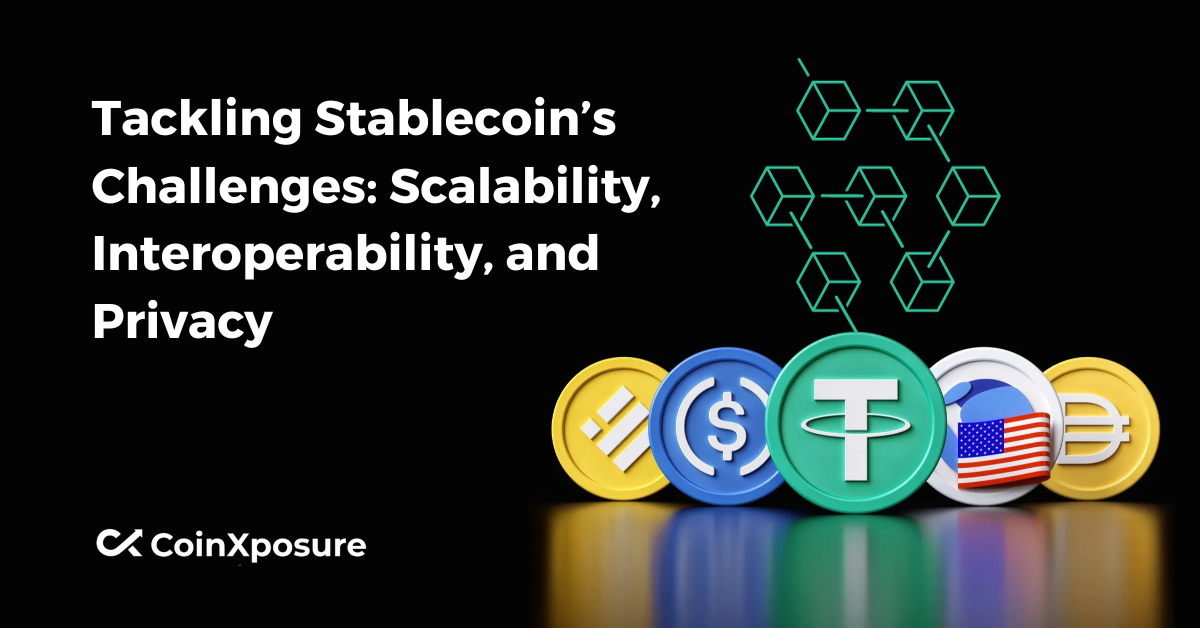
Tackling Stablecoin’s Challenges: Scalability, Interoperability, and Privacy
The advent of Stablecoin brought a new dawn in the world of digital currencies. This article will discuss Stablecoins and will also look at tackling stablecoins’s challenges.
Stablecoins, a famous type of cryptocurrency, are supposed to keep their value stable by being tied to another asset, like the US dollar. However, stablecoins have only sometimes lived up to their promise of stability.
Some of the biggest stablecoins by market value have seen their prices drop below the prices of their paired assets more than once in the past few years.
This is called a “depeg,” and it’s been seen in stablecoin price tracking from Amberdata, a company that collects and analyzes data on digital assets. This has made it harder for stablecoins to get more users.
There are signs that stablecoins could be used more, like the fact that PayPal and Visa have announced new projects that will use them, but price fluctuations are still a big problem that needs to be fixed.
Before we look at stablecoins’s challenges and how to tackle them, let’s get background knowledge on what Stablecoin is.
What is Stablecoin?
Stablecoins are digital currencies linked to a “stable” reserve asset, such as the US dollar or gold. Stablecoins are intended to lessen volatility compared to unpegged cryptocurrencies such as Bitcoin.
Because their prices are fixed to a reserve asset such as the US dollar or gold, stablecoins bridge the worlds of cryptocurrencies and regular fiat currency.
Compared to Bitcoin, this significantly minimizes volatility, resulting in a kind of digital money better suited to everything from day-to-day commerce to facilitating transfers across exchanges.
Combining traditional asset stability with digital asset flexibility has proven highly appealing.
Stablecoins like USD Coin (USDC) have attracted billions of dollars, becoming one of the most popular ways to store and transfer wealth in the crypto ecosystem.
These days, the exchange is stocked with stablecoins. The public’s trust in digital currencies is restored as these coins gradually become more widespread.
Although other initiatives still need to achieve the necessary level of success, the popular ones remain strong.
Even though it may seem pointless to have so many stablecoin projects when they all produce the same result, to be more specific, the mechanisms behind each stable token are different.
Some of them use alternative protocols or approaches to keep the value stable.
Every Stablecoin uses collateral and then manipulates its supply to keep the market steady. Money-backed stable tokens keep real money in reserve to guarantee a redeemable currency in return for tokens.
“Holding a stable value in any case” is the simplest way to describe the initial algorithms that underpin each coin, even though they might appear somewhat complex.
Importance of Stablecoins
The USDC stablecoin, for example, is backed by dollar-denominated assets in segregated accounts with US-regulated financial institutions that have at least equal fair value to the USDC in circulation.
An independent accounting company attests to (i.e., publicly verifies) such accounts. USDC, like many other stablecoins, is currently decentralized on the Ethereum blockchain.
Stablecoins lack the volatility of non-pegged cryptocurrencies while retaining some of their most potent features, which include:
- Stablecoins are open worldwide and available to everyone on the Internet anytime.
- They transport data quickly, cheaply, and securely.
- They are digitally native to the Internet and may be programmed.
Types of Stablecoins
All stablecoin cryptocurrencies use the same algorithms. However, this is different here.
Various stablecoins are listed on the market, each with its process. These are often classified into three types of coins;
- Commodity-backed stablecoins
- Cryptocurrency-backed stablecoins
- Algorithmic-backed stablecoins
Commodity-backed Stablecoins
This kind of Stablecoin is backed by commodities such as gas, gold, precious metals, etc. All these commodities will always have a constant value on the network.
Products can be classified as fungible assets because they can be traded for actual cash on the same market. Many of you may have supplies on hand for rainy days.
One of the most common is gold, a precious metal with a high market value. Gold is a precious metal that has been used as an adornment for years.
As a result, there will always be demand for this metal and other precious metals on the market. As a result, it will always be transferable. Other precious metals have high demand, although less high than gold.
Investors accumulate this metal and perceive it as a secure bet compared to other metals.
A stablecoin backed by gold will always have a defined value allocated to each coin. One gold stablecoin, for example, may represent one gram of gold. However, you may be wondering where the physical gold is.
These golds are held in a secure, trustworthy vault, although a third party is involved in most situations.
As a result, your stable currency crypto corporation would engage third-party services to provide you with this type of luxury item. Consider it before investing in these coins.
Cryptocurrency-backed Stablecoins
This form of stable token is backed by cryptocurrency. Popular cryptocurrencies with high market value, such as Ethereum or Bitcoin, are used here.
Typically, these coins are backed by a mix of multiple cryptocurrencies rather than a single one. This structure eliminates the possibility of volatility.
If you just employ one cryptocurrency to back up this stablecoin price, the primary aim of Stablecoin is rendered null and void.
It is a coin backed up by another coin, which makes this redundant in the first place.
However, if this stablecoin price is supported by a variety of cryptocurrencies, even if one of the cryptocurrencies has a significant price drop, other currencies can compensate.
This system works and keeps the tokens’ value stable. Because cryptocurrencies are highly volatile assets, investing in just one is extremely dangerous.
Another advantage of cryptocurrency-backed stablecoins is that they are highly collateralized. This structure is required to keep the cryptocurrency market’s value swings stable.
Making more than the situation requires mitigation of the impact of a sudden price drop.
A typical scenario for these stablecoins is when users stake their coins in a smart contract, generating a fixed ratio of stablecoins.
Algorithmic-backed Stablecoins
This coin category is unique. They don’t have any assets to back them up; instead, they employ an algorithm to burn or add cryptocurrency to keep the value stable.
This currency uses a controlled way to assure the expansion or limitation of coins on the network. The technology ensures that the tokens have a consistent value.
When demand rises, fresh coins are struck, which helps to moderate the price increase.
However, the primary goal remains the same: get the value as near to $1 as possible. Unfortunately, this sort of Stablecoin was not as popular as the others.
However, the scenario is changing as this type of Stablecoin can affect the price of stablecoins.
Now, let us look at some of the stablecoins’s challenges.
Examples of Stablecoins’s Challenges
Some stablecoins’s challenges include;
- Scalability
- Interoperability
- Privacy
Scalability
The first one of stablecoins’s challenges we will discuss is scalability. As the demand for stablecoins increases, providing scalability while preserving stability becomes more difficult.
Concerns about “scaling” rank high among stablecoins’ challenges. It is difficult for reserve-backed stablecoins to achieve sufficient liquidity to support exciting technology applications.
Backers will have to invest millions, if not billions, of dollars in each coin. It may impose a limit on how quickly a stablecoin can grow.
Interoperability
Interoperability is one of stablecoins’s challenges. The future of stablecoins is intimately linked to interoperability as big banks and financial institutions begin to establish their stablecoins or tokenized deposit systems.
However, due to the market’s competitive nature, interoperability between these several stablecoins could be better.
As banks seek to promote the tokenization of their goods, this need for compatibility extends to DeFi and bank-issued stablecoins.
In the long run, solutions such as decentralized exchanges or cross-chain interoperability protocols may arise to allow interoperability amongst stablecoins, as they do for DeFi.
As the industry matures, large firms may acquire smaller stablecoin issuers, consolidating the market and making it easier for users to switch between stablecoins and platforms.
Privacy
Another one of stablecoin’s challenges is privacy. Regarding data privacy in the context of stablecoin usage, two significant flaws emerge: user permission and control and regulatory compliance issues.
Given the complexity of stablecoin transactions, users may need help comprehending and consenting to the gathering and using of their data.
Furthermore, ensuring compliance with data protection rules can be difficult because stablecoin platforms operate in many jurisdictions with varying privacy laws.
These flaws underscore the importance of strong privacy rules and transparent policies to secure the data of stablecoin users.
Tackling Stablecoins’s Challenges
A significant way of creating trust and solving Stablecoin’s challenges is through comprehensive transparency, enhanced scalability, interoperability, and privacy.
Tether’s competitors have capitalized on its flaws by releasing their books to the public and assuring their stablecoins are 100% backed by US dollars.
USDK is one such product. The ERC-20 stablecoin was launched in June 2019 by blockchain technology startup OKLink and U.S.-licensed trust corporation Prime Trust, with funds escrowed independently.
According to the operator, it provides a guaranteed 1:1 conversion rate between USDK and USD, and its monetary worth is 100% safeguarded.
To that purpose, third-party organizations such as Certik and Slowmist execute smart contract audits.
At the same time, independent auditing firm Armanino offers monthly reports of the USD held by Prime Trust for USDK token holders to provide maximum transparency to the public.
USDK trades on key exchanges OKEx and Bitfinex and provides the liquidity required for financial participants to use the Stablecoin.
Conclusion
Stablecoins can change how people access and use financial services, especially in developing nations and places where traditional financial services are scarce.
Providing stability and security promotes financial inclusion, decreases poverty, and stimulates economic progress.
It will be intriguing to witness how Stablecoin uses cases and challenges that affect the global economy and encourage financial advancement as they mature.





